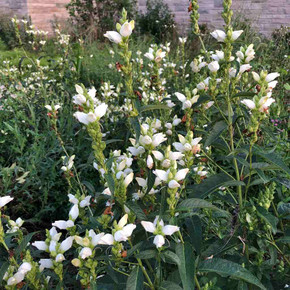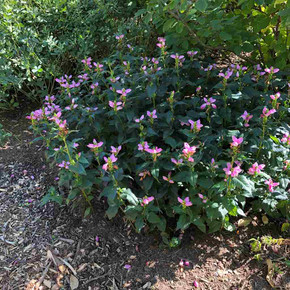
Chelone glabra 'Black Ace' - WHITE TURTLEHEAD 'BLACK ACE'
Cultivar 'Black Ace' offers nearly black sprouts and foliage in the early season (leaves turn green at the beginning of summer).
Taller and slender-looking perennial with white turtlehead-like flowers in August to September. Grows into narrow, upright clumps that slowly spread by rhizomes.
Blooming Time: August to September
Size: usually 4' tall x 1.5' wide(up to 6' in ideal conditions)
USDA Zones: 4/5 to 8
Culture: half shade, full sun with consistent moisture
Moisture Needs: medium (average), moist to wet, wet
Origin: Named and introduced by The Plant Delights nursery (Raleigh, NC), but originaly came from collections of NC plantsman Dr. Craig Moretz. The species of Chelone glabra isnative wildflower to the eastern part of the USA, where it naturally occurs in moist woods, swampy areas and along streams (see the USDA distribution map)
Deer/Rabbit Resistant: yes / yes
Attracts Butterflies or Pollinators: butterflies
Attracts Hummingbirds: rarely
Pot Size: square 3.5" x 4" deep perennial pot
Plant Combinations: The best uses are in shade gardens, woodland gardens, bog gardens, naturalized in wet meadows, banks of ponds, water bodies, streams or even in moist flower beds or pollinator gardens. White turtlehead can flop in rich soils and too-shady areas, so it's best if there are other taller plants around to support it. The "Chelsea Chop" (cutting back in early May) will make the stems shorter and sturdier.
Picture copyright : Michael Wolf, Commons Wikipedia (picture shows the species of C. glabra)

Chelone glabra 'Black Ace' - WHITE TURTLEHEAD 'BLACK ACE'
Cultivar 'Black Ace' offers nearly black sprouts and foliage in the early season (leaves turn green at the beginning of summer).
Taller and slender-looking perennial with white turtlehead-like flowers in August to September. Grows into narrow, upright clumps that slowly spread by rhizomes.
Blooming Time: August to September
Size: usually 4' tall x 1.5' wide(up to 6' in ideal conditions)
USDA Zones: 4/5 to 8
Culture: half shade, full sun with consistent moisture
Moisture Needs: medium (average), moist to wet, wet
Origin: Named and introduced by The Plant Delights nursery (Raleigh, NC), but originaly came from collections of NC plantsman Dr. Craig Moretz. The species of Chelone glabra isnative wildflower to the eastern part of the USA, where it naturally occurs in moist woods, swampy areas and along streams (see the USDA distribution map)
Deer/Rabbit Resistant: yes / yes
Attracts Butterflies or Pollinators: butterflies
Attracts Hummingbirds: rarely
Pot Size: square 3.5" x 4" deep perennial pot
Plant Combinations: The best uses are in shade gardens, woodland gardens, bog gardens, naturalized in wet meadows, banks of ponds, water bodies, streams or even in moist flower beds or pollinator gardens. White turtlehead can flop in rich soils and too-shady areas, so it's best if there are other taller plants around to support it. The "Chelsea Chop" (cutting back in early May) will make the stems shorter and sturdier.
Picture copyright : Michael Wolf, Commons Wikipedia (picture shows the species of C. glabra)









